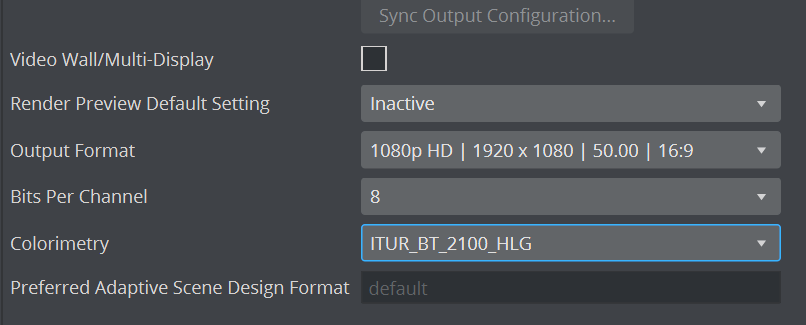High Dynamic Range (HDR) introduces new workflows and requirements in video production. This document outlines the main use cases involving HDR, the interaction between environment and scene configurations, and the necessary conversions between SDR (Standard Dynamic Range) and HDR.
The environment refers to the format of video signals and clips in use. It is generally static, with the engine supporting both SDR and HLG signals (the configuration must match the environment). Configuration details are described in the Administrator Guide.
Note: The incoming signal needs to match the configuration.
The scene can be either SDR or HDR, but classic scenes are always SDR. Starting with Viz Engine 5.4, it is possible to create VER scenes in either SDR, or HDR. VER scenes built in earlier versions are SDR.
HDR scenes define as scenes that use the linear BT.2100 color encoding. The color encoding of a scene should be determined in advance and remain unchanged. The scene color limits are also relevant for HDR, the default limits of 0 and 1 clamp the output to nominal signal range. Using superblack and superwhite requires relaxed or disabled color limits.
The use case is defined when combining the environment with the scene type. The traditional use case, where both are SDR, is not covered in this document. Any difference between environment and scene, requires conversion.
Input and output must always match the environment, and the required configuration for HDR conversions is similar across different scenarios.
SDR Scenes in an HDR Environment
This is the most common scenario when introducing HDR workflows, as the majority of the existing scenes, are built in SDR. It allows for compatibility with existing SDR content, and requires minimal redesign. A major advantage of SDR scenes, is that they are built in the color space that is most familiar to the majority of designers.
Existing SDR scenes can be used as overlays or graphics on HDR video signals, or integrated into HDR environments. In this setup, graphics are limited to SDR, and video within the scene is converted to SDR, while the video used in the scene background remains HDR. The recommended scene design is an input as scene background, or DVE with an SDR overlay. Depending on the render sequence, the conversion is applied to keyed elements of a scene.
This use case requires an SDR to HDR conversion, and LUT to embed SDR scenes into HDR signals. If HDR inputs should be used within a scene, an HDR to SDR conversion is required as well.
HDR Scenes in an HDR Environment
This is the native approach for full HDR workflows, and the sole method to use HDR’s full capabilities.
Scenes must be designed from scratch in HDR, using the linear BT.2100 color space. If all assets are HDR, no conversions are required. However, SDR assets require conversion using an SDR to HDR LUT. HDR to SDR conversion is not necessary, but should be enabled in the configuration, if it is possible that SDR scenes are used as well.
HDR Scenes in an SDR Environment
This scenario is typically used as a backup, or a transitional solution when existing HDR scenes need to be used in an SDR-only environment. The final output is in SDR. There is generally no benefit in designing new HDR scenes for SDR environments, but existing HDR scenes can be reused this way. Conversions from and to HDR are needed.
Limitations and Known Issues
The precision keyer is only supported in pure SDR environments.
Postrendering, ClipOut as well as NLE workflows, are not supported.
Image Export and Snapshots are not supported.
Image Editor is not able to handle HDR images. We recommend using an external image editor instead.

